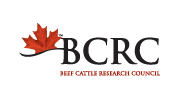The Role of Forages in Sustainable Beef Production
| Project Code: | 8.43 |
| Completed: | April 2011 |
Project Title:
Developing a Strategy for Forage and Grassland Management through an Examination of the Multi-Functionality of Forages in Terms of Productivity and Environmental Sustainability
Researchers:
Kim Ominski, Ph.D. k_ominski@umanitoba.ca
Karin Wittenberg, Ermias Kebreab, and Suren Kulshrestha
Background:
Forages and grassland have always been a critical resource for beef production in Canada. Traditionally, the main competing use for forage and grassland has been crop production for human and livestock feed. High grain and oilseed prices encourage farmers to convert forage and grassland to crop production. The increased use of grain-based ethanol and biodiesel for vehicles is also contributing to increases in the worldwide demand and price of grains and oilseeds.
Converting grassland to grain and oilseed production fails to consider the inherent ecological and broader economic benefits of forage production. There is a growing recognition that forages and grasslands play an important role in environmental sustainability (by naturally promoting carbon sequestration, animal and plant biodiversity, reduced soil erosion, improved water management, etc.) along with other potential benefits (agricultural diversification, agri-tourism and grass-fed beef production).
The relative economic and societal benefits of these alternative land uses have not been clearly determined. It is important to collect this information in Canada. For example, methane production and carbon sequestration collected from breeds, feeds, plant species and climates elsewhere in the world may not accurately describe what happens in Canada. This makes it difficult for Canada to develop sound public or industry land use policy.
Objectives:
To accurately assess how Manitoba’s forage and grasslands are currently being used, and to calculate the cost:benefit ratio of forage and grasslands.
What they did:
The research team focused on Manitoba’s grasslands. In addition to forage value, they identified 20 potential EG&S, and estimated the value of eight of them (carbon sequestration, nutrient cycling, water quality, soil erosion control, soil formation, water treatment, recreation and aesthetics, and wildlife habitat). Forage and seed yields and prices were relatively easy to measure and value. The EG&S weren’t. For example, carbon sequestration data was limited, so they used data from grasslands at similar latitudes elsewhere in the world, and applied a carbon price from the Chicago Climate Exchange (this pre-dated Canada’s carbon taxes). The amount of nitrogen fixed by forage legumes was estimated and priced the same as urea. Other EG&S were even harder to estimate and value. Water quality and benefits from reduced water and wind erosion were based on a previous study of the upper Assiniboine River Basin in Saskatchewan and Manitoba. The data on how well grasslands remove excess nitrogen and phosphorus from the soil wasn’t strong, so data from forests was used instead. The rate of soil formation in grasslands had been measured elsewhere in the world and were assumed to be similar in Manitoba. Recreation and scenery values were estimated from hunting revenues. Wildlife habitat values came from a federal report about burrowing owl habitat in Southern Alberta. Information from other international studies were used when no other estimates or values were available, and to supplement other data when appropriate.
What They Learned:
A few key points were apparent. Firstly, only a third of the total value from Manitoba grasslands (33%) came from forage; the rest came from the EG&S. The largest EG&S contribution (42%) came from carbon sequestration. No other EG&S accounted for more than 10% of the total. The main thing this study found was how much we don’t know. We don’t have enough Canadian data to accurately estimate how much EG&S grasslands provide, and we don’t know what most EG&S are worth to society.
What it Means:
Implementing an effective program to pay beef producers for EG&S will be challenging and this study raised more questions than answers.To answer these questions, more research is needed to measure how forage and beef production practices impact greenhouse gas production and sequestration, soil health, watersheds and cycles, and plant and wildlife habitat. Regardless of how or whether producers are paid for EG&S, more knowledge of the EG&S that Canada’s beef producers provide will help the public understand that beef producers and environmentalists are often on the same side, and that Canada’s beef industry is environmentally sustainable.






